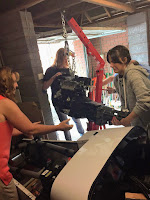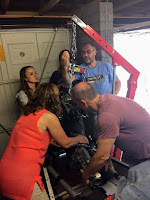took the opportunity to check the centralization of the engine in the chassis , all good:
I also removed the thermostat housing in readiness for the GBS water rail kit. In hindsight I would recommend you remove this BEFORE the engine goes in. It is held on by three bolts of which the bottom one, is dead level with a cross member on the scuttle. There is just enough room to loosen this bolt and for the thermostat housing to come away, so not a big showstopper by any means but on reflection, easier to do before the engine is dropped into the chassis
I also checked the bellhousing against the transmission tunnel - you do need to ensure some of the bellhousing is cut away before dropping the engine/gearbox in. Although the picture does not show this too well, thankfully I had judged how much to cut away late last year and there is enough space for it not to snag (picture below middle right shows the cutting which has to be made)
I have not yet, drilled and bolted the engine mounts into chassis as there may still need to be some slight adjustment left/right depending how ancillaries are fitted and routed in the engine bay. It is not moving anywhere fast and is solid in the chassis so I am happy to leave it for the interim. Once I have get better comfort on the ancillaries i'll get it drilled and bolted.
The radiator, steering column and oil dipstick were also put back in place.
Some pictures of the installation as it currently stands:























